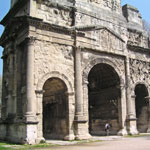
Standing just at the northern entrance to the city, the great Triumphal Arch certainly makes an impression on the newly arriving visitor! The main north-south road into town (the Via Agrippa coming from Lyons outside of town; the cardo maximus in town) once passed through the famous arch. Now a rotary goes around it to keep the busy traffic away and to help preserve the monument. The date of the arch's construction is in question, though many scholars favor the time of Tiberius in the first century. Strictly speaking, it is not a "triumphal" arch as those that were granted to successful generals when they entered Rome in a triumphal procession following a major military victory. This one no doubt celebrated a military victory of Romans over Gauls--but which one is a matter of debate. The structure has three arched openings--a wider, taller one in the center and a narrower, lower one to either side. It is thought to be the earliest surviving triple arch. On the broad sides, the arches are framed by engaged Corinthian half-columns, above which on either side runs an entablature with pediment over the central opening. Topping off the whole thing are two attic stories that project and recede in somewhat baroque manner, and are separated by a heavy horizontal cornice. The engaged half-columns and entablature are carried around to the short sides where another pediment projects up into the first attic. Above the two central half-columns and under the pediment is a blind arch. The structure is built of limestone blocks, set without mortar, and lavishly decorated with panels of sculpture celebrating military victories on both land and sea. The sculpture is executed in a rather linear and "provincial" style, similar to that on the less-well-preserved arch at Carpentras. Originally, the arch also served as a huge base for a colossal freestanding statue, possibly of the emperor in a chariot (as this was typical of such arches). All traces of the statue group have disappeared along with the dedicatory inscriptions. The holes on the upper facades mark where inscriptions and other attachments in bronze have been removed. If we had the original inscriptions, we would know to whom the arch was dedicated and thus what battle it commemorates and its date.
 Arch Overview |
 Arch Details |
Advertisement

Advertisement







